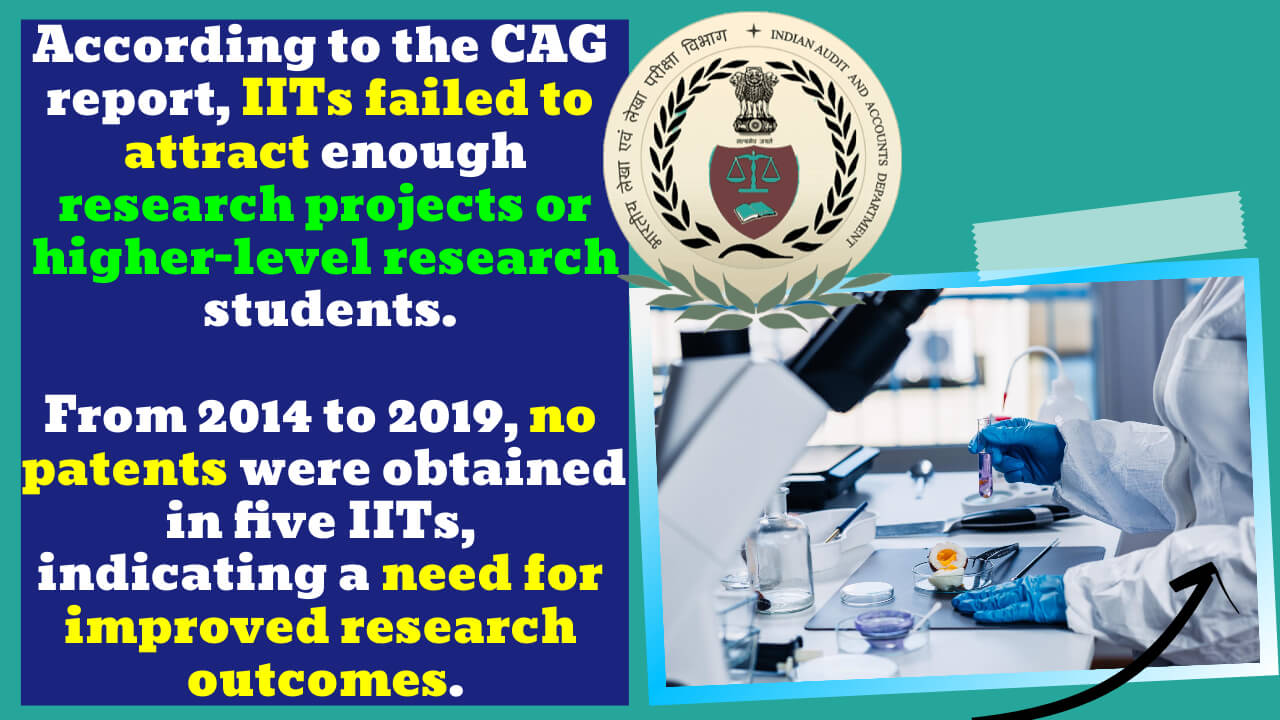All eight IITs failed to attract enough non-government-funded research projects or acquire land for student facilities.
It took three years for IIT Hyderabad to use available Japan International Cooperation Agency (JICA) loan funds. According to an Indian Institute of Information Technology (IIT) report, the benefits of education at premier technical institutes are not reaching students from reserved categories.
Key Highlight:
- The CAG reported that all eight Indian Institutes of Technology (IITs) failed to attract enough non-government-sponsored research projects, take land for student facilities, or attract students for higher research.
- According to the report, non-government funded projects ranged from 3.5% to 14.31%.
- Despite numerous patent filings, no patents were obtained in five IITs from 2014 to 2019, indicating a need for improved research outcomes.
- According to the report, the failure to meet infrastructure development targets impacted student intake at all eight IITs and equipment installation and fund management.
- Despite the IITs’ efforts and annual increases in faculty recruitment, seven IITs had vacancies ranging from 5 to 36%.
The Comptroller and Auditor General (CAG) said that all eight Indian Institutes of Technology (IITs) couldn’t get enough non-government-funded research projects, get land for facilities for students, or get students to do more research.
IIT Hyderabad had a three-year delay in using funds from the Japan International Cooperation Agency (JICA) loan. This meant that the intended goal of advancing academic and research activities on the campus was not met, said a report in Parliament on December 21.
A decade after the Indian Institutes of Technology (IITs) were set up; there were still problems with allotment and land transfer. IITs couldn’t provide planned facilities to students because they didn’t have enough land.
The report said that non-government-funded projects made up between 3.5% and 14.31% of project funds. Many patents were filed at five IITs between 2014 and 2019, but no patents were granted. This shows that more needs to be done to make research more effective, the report said.
The audit found that the proportion of the IITs’ internal receipts, such as fees, interest, consulting work, and publications, to their recurring expenses was deficient, even though they had been around for a while. This made them rely heavily on grants from the government to pay for their recurring expenses.
While the Education Ministry had hoped that each IIT would have a Research and Technology Development Council in its governing structure, it was found that many IITs were still in the early stages of setting up the Councils, which was slowing down the pace of research and development in them.
According to the report, the eight IITs didn’t meet their infrastructure development goals on time. This, along with the timely installation of equipment and proper fund management, affected the number of students who came to the IITs.
Capital outlay also had to be changed from Rs 6,080 crore to Rs 14,332 crore, and the project period to 13 years, it said.
Vacancies were found in PG and Ph.D. programs at all eight IITs, which shows that these programs need to be realistically assessed and evaluated to attract the right students.
The Education Ministry has allowed the number of faculty positions to rise with students. For example, faculty positions can rise by one for every 10 more students (1: 10 ratio). Despite the efforts of the IITs and the rise in the number of faculty hired each year, there were vacancies in seven IITs that ranged from 5% to 36%.
There were also not enough students from reserved groups (SC/ST/OBC) in the PG and Ph.D. programs at all eight IITs, which shows that the benefits of education at top technical schools aren’t reaching these students.
SC students missed out on up to 30% of seats in PG courses, while ST students missed between 7% and 70% of seats in PG courses (IIT Gandhinagar).
According to the report, there was a shortfall of 25% to 75% in Ph.D. courses in terms of SC students and 66% to 100% in terms of ST students.





[…] IITs failed to attract enough research projects, or higher research students:… […]